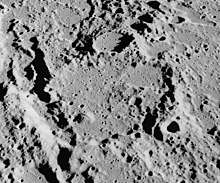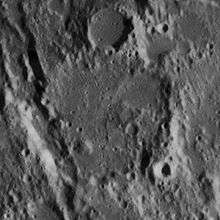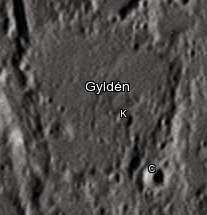Gyldén (crater)
Gyldén is the remnant of a lunar impact crater that is located to the northeast of the walled plain Ptolemaeus on the Moon. Its diameter is 48 km. It is named after the Finland-Swedish astronomer Hugo Gyldén.[1] It lies along the prime meridian of the selenographic coordinate system, and less than 150 km south of the lunar equator. Nearby craters of note include Herschel to the west, the flooded Réaumur to the north, and Hipparchus to the east.

 Lunar Orbiter 4 image | |
| Coordinates | 5.3°S 0.3°E |
|---|---|
| Diameter | 48 km |
| Depth | 1.8 km |
| Colongitude | 0° at sunrise |
| Eponym | Hugo Gyldén |
The heart-shaped rim of this crater is in poor condition, having been eroded by impacts until the disintegrating remnants form an uneven ring of peaks and valleys around the interior floor. The satellite crater Réaumur A is attached to the northern rim. A wide cleft cuts through the western rim, continuing to the north-northwest past Spörer. The interior floor is relatively featureless, although the small crater Gyldén K is located just to the southeast of the midpoint.
Satellite craters

By convention these features are identified on lunar maps by placing the letter on the side of the crater midpoint that is closest to Gyldén.
| Gyldén | Latitude | Longitude | Diameter |
|---|---|---|---|
| C | 5.8° S | 1.0° E | 6 km |
| K | 5.5° S | 0.6° E | 5 km |
See also
- 806 Gyldénia, minor planet
References
- "Gyldén (crater)". Gazetteer of Planetary Nomenclature. USGS Astrogeology Research Program.
- Andersson, L. E.; Whitaker, E. A. (1982). NASA Catalogue of Lunar Nomenclature. NASA RP-1097.CS1 maint: ref=harv (link)
- Bussey, B.; Spudis, P. (2004). The Clementine Atlas of the Moon. New York: Cambridge University Press. ISBN 978-0-521-81528-4.CS1 maint: ref=harv (link)
- Cocks, Elijah E.; Cocks, Josiah C. (1995). Who's Who on the Moon: A Biographical Dictionary of Lunar Nomenclature. Tudor Publishers. ISBN 978-0-936389-27-1.CS1 maint: ref=harv (link)
- McDowell, Jonathan (July 15, 2007). "Lunar Nomenclature". Jonathan's Space Report. Retrieved 2007-10-24.CS1 maint: ref=harv (link)
- Menzel, D. H.; Minnaert, M.; Levin, B.; Dollfus, A.; Bell, B. (1971). "Report on Lunar Nomenclature by the Working Group of Commission 17 of the IAU". Space Science Reviews. 12 (2): 136–186. Bibcode:1971SSRv...12..136M. doi:10.1007/BF00171763.CS1 maint: ref=harv (link)
- Moore, Patrick (2001). On the Moon. Sterling Publishing Co. ISBN 978-0-304-35469-6.CS1 maint: ref=harv (link)
- Price, Fred W. (1988). The Moon Observer's Handbook. Cambridge University Press. ISBN 978-0-521-33500-3.CS1 maint: ref=harv (link)
- Rükl, Antonín (1990). Atlas of the Moon. Kalmbach Books. ISBN 978-0-913135-17-4.CS1 maint: ref=harv (link)
- Webb, Rev. T. W. (1962). Celestial Objects for Common Telescopes (6th revised ed.). Dover. ISBN 978-0-486-20917-3.CS1 maint: ref=harv (link)
- Whitaker, Ewen A. (1999). Mapping and Naming the Moon. Cambridge University Press. ISBN 978-0-521-62248-6.CS1 maint: ref=harv (link)
- Wlasuk, Peter T. (2000). Observing the Moon. Springer. ISBN 978-1-85233-193-1.CS1 maint: ref=harv (link)
External links
| Wikimedia Commons has media related to Gylden (crater). |
- Gylden at the Moon Wiki
- LTO-77B4 Gyldén — L&PI topographic map